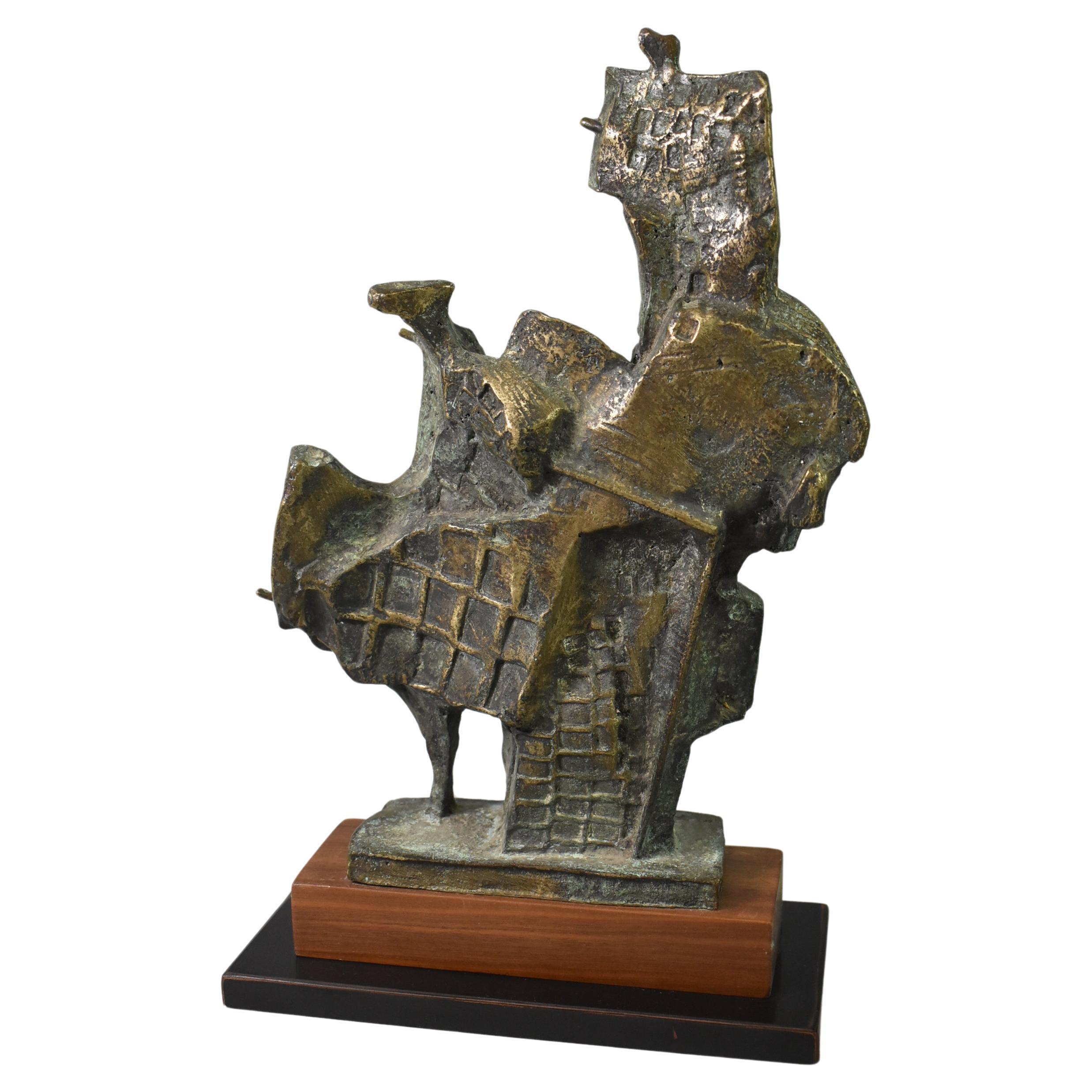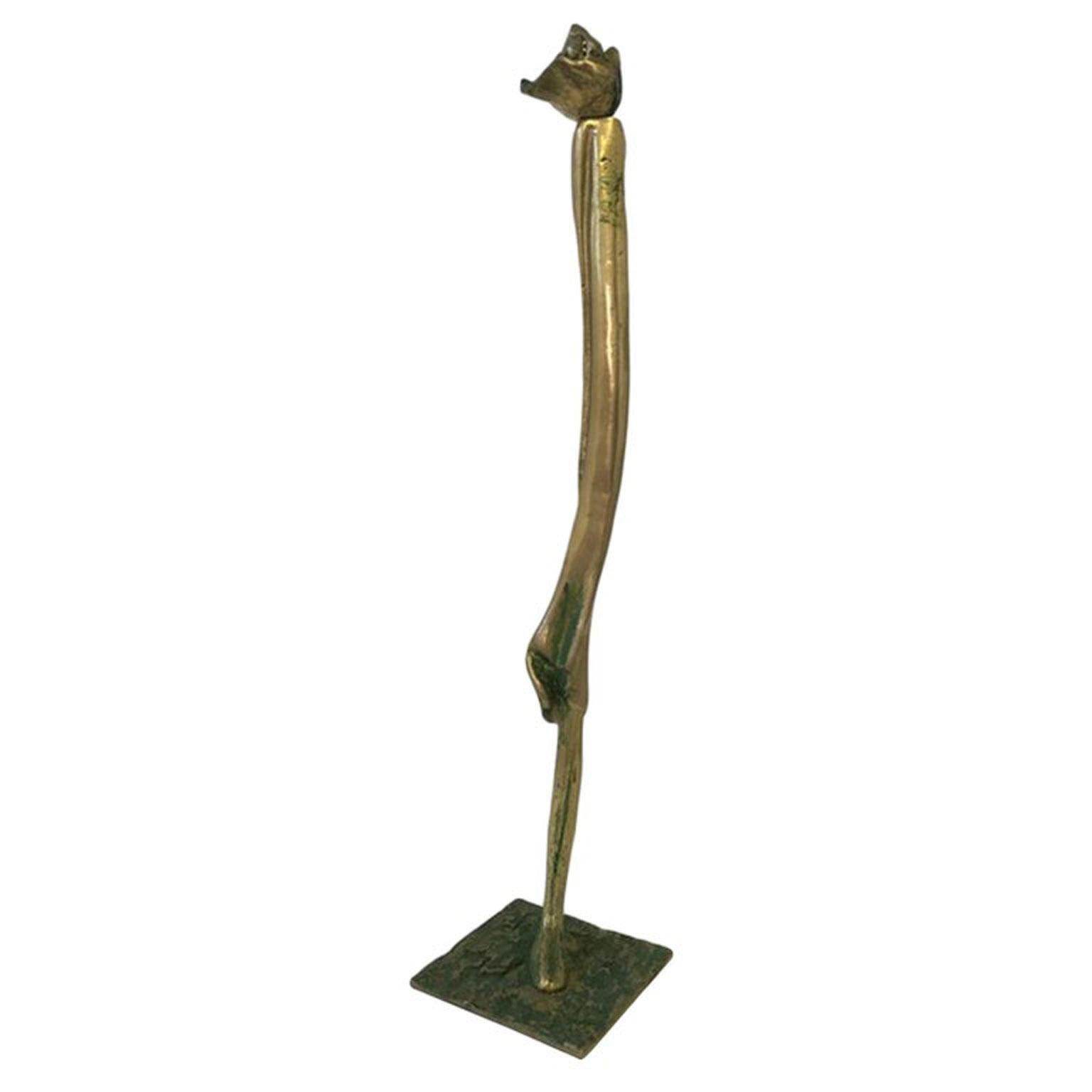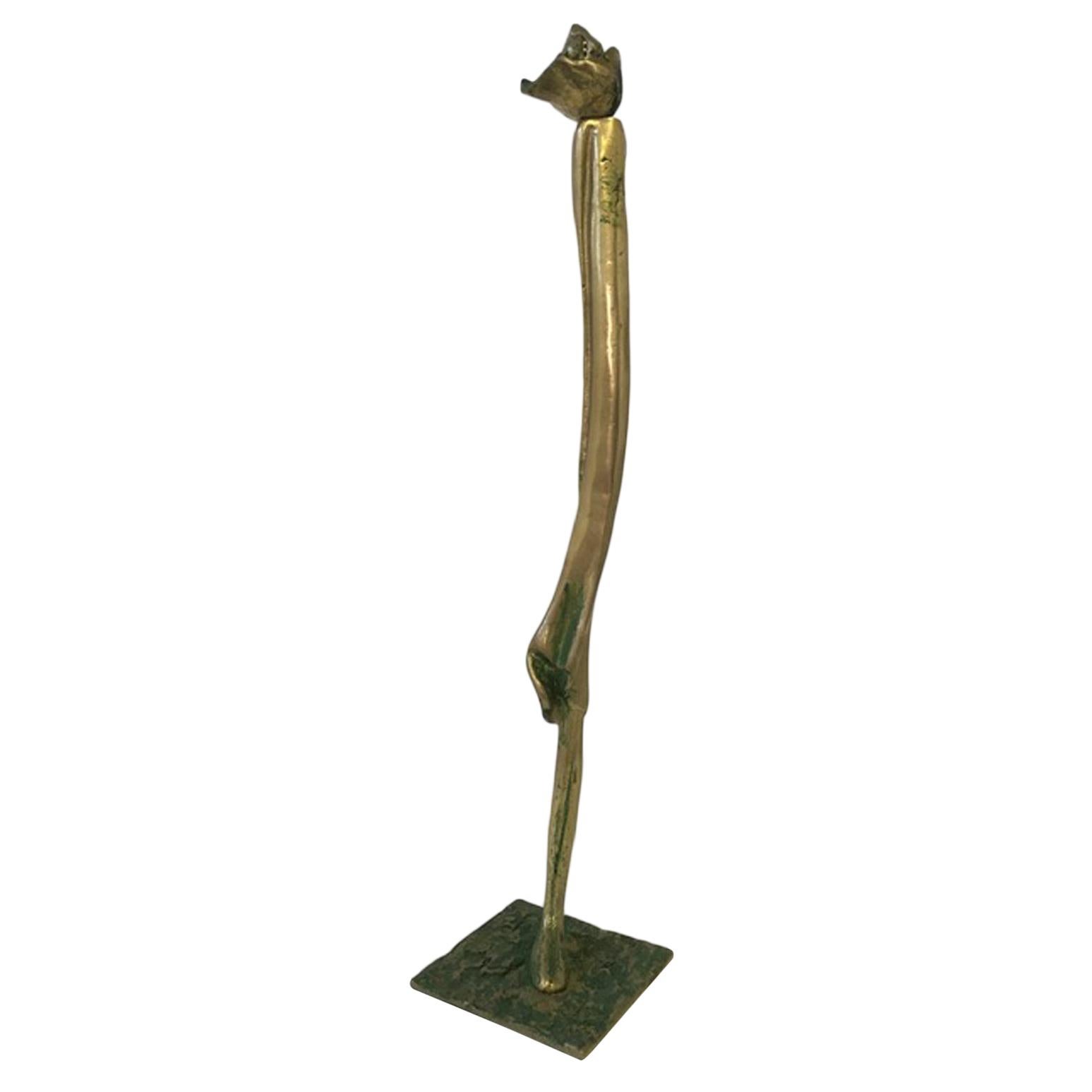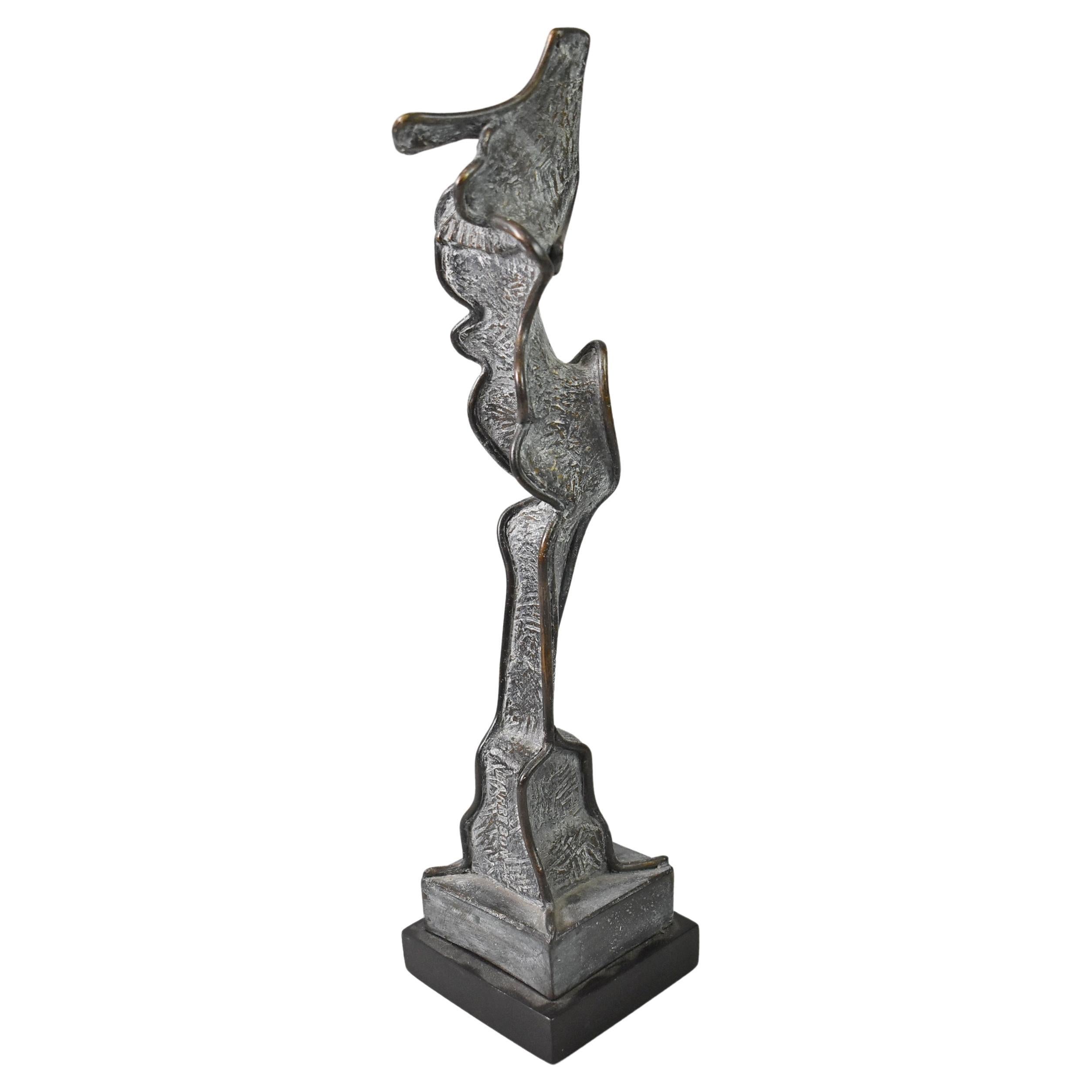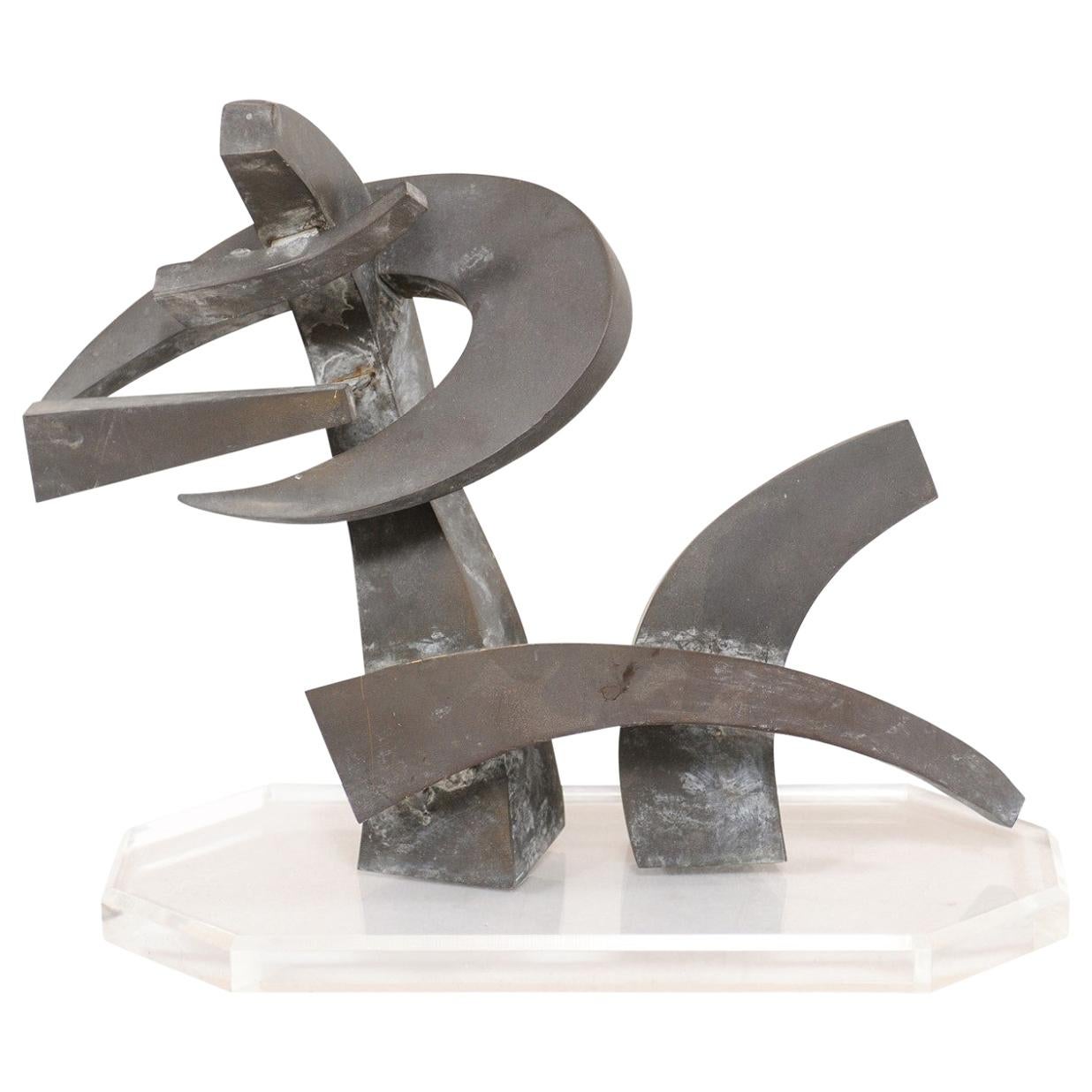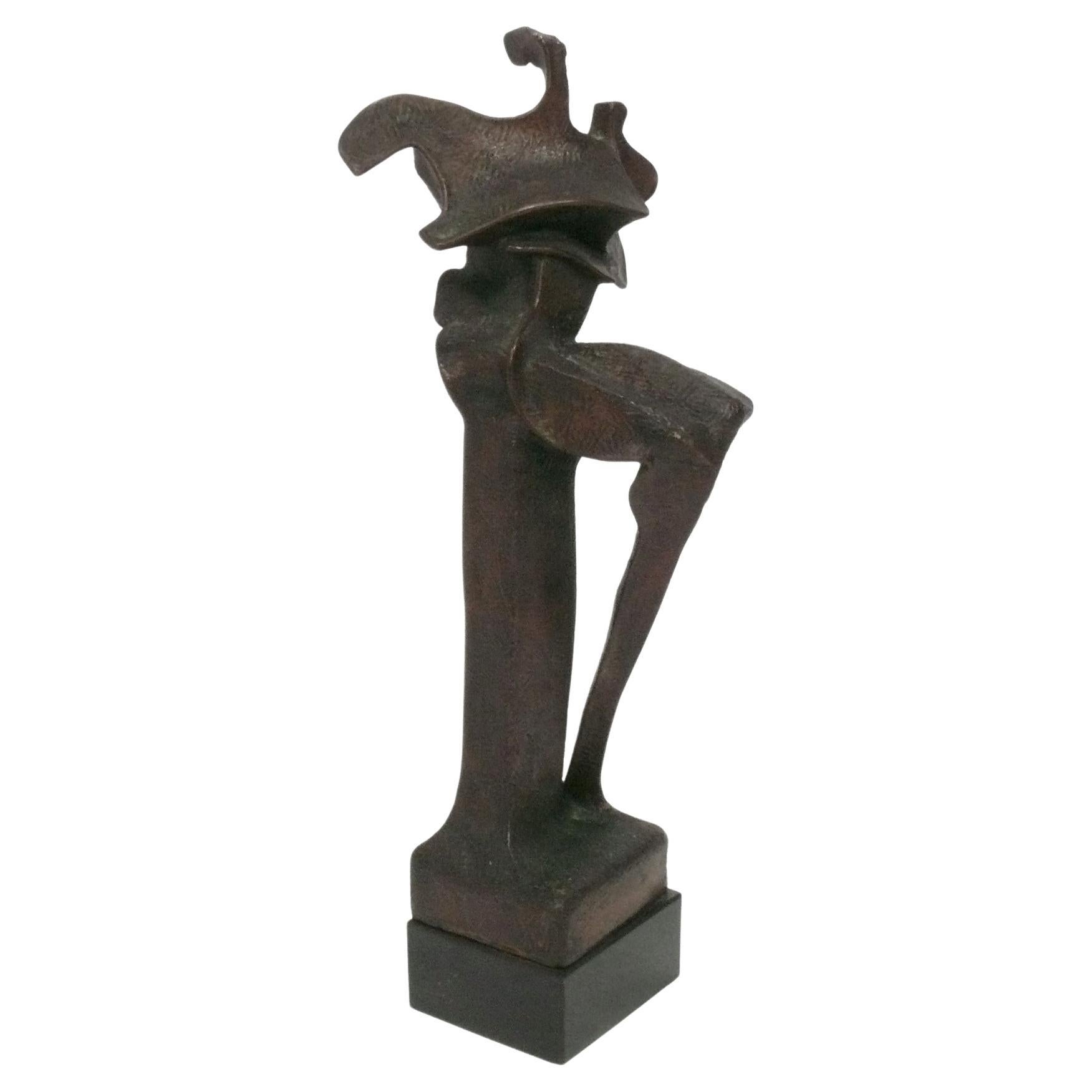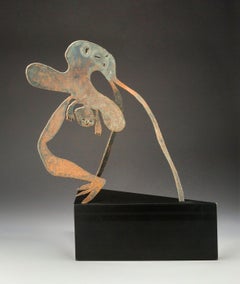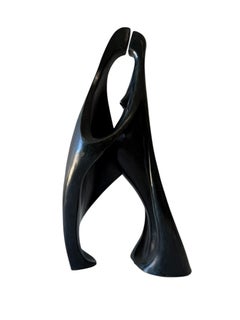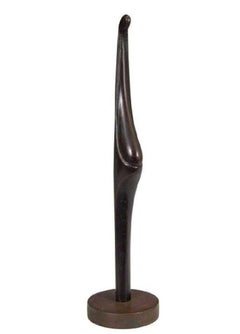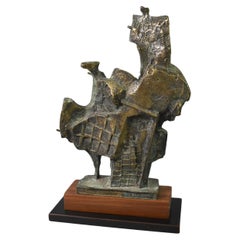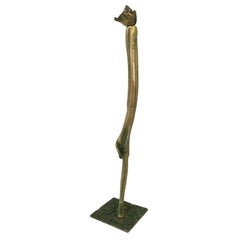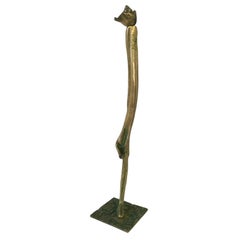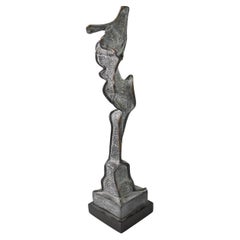Items Similar to Abstract Signed Cubist Bronze Sculpture "Cats" Chicago Bauhaus Woman Modernist
Want more images or videos?
Request additional images or videos from the seller
1 of 10
Marie Zoe Greene-MercierAbstract Signed Cubist Bronze Sculpture "Cats" Chicago Bauhaus Woman Modernistc.1960
c.1960
$3,800
£2,900.77
€3,334.63
CA$5,347.28
A$5,946.40
CHF 3,123.18
MX$72,700.66
NOK 38,917.77
SEK 36,688.94
DKK 24,887.10
About the Item
This listing is just for the sculpture. (the picture of the ad is for reference and is not included.)
Marie Zoe Greene-Mercier was an artist, writer and arts activist who worked in the United States and Europe in the mid- to late-twentieth century. Educated at Radcliffe College, Greene-Mercier was also a student at the New Bauhaus School of Design in Chicago. Greene-Mercier worked in a variety of media, but was best known for the abstract metal sculptures she produced in the 1950s-1970s. An American artist born to French immigrant parents, Greene-Mercier studied art at Radcliffe College. A working artist since the 1940s, Greene-Mercier began to produce primarily large, abstract sculptures cast in bronze in the 1950s. She began creating small- and large-scale works in the heavier “Cubic” style in the late 60s, and monumental sculptures in this mode would characterize her work in the 1970s.
Marie Zoe Greene-Mercier was born March 31, 1911 in Madison, Wisconsin. Both of her parents were French immigrants; her father, Louis J.A. Mercier, served on the faculties of University of Wisconsin and Harvard University before returning to France to serve in World War I. Greene-Mercier described her family life during this time as "itinerant," but stability returned after the war. As a child, Greene-Mercier attended Catholic schools in the Boston area. After high school, she studied and traveled in Europe before entering Radcliffe College, where she earned a bachelor's degree in fine arts in 1933.
Greene-Mercier's early career included work as a French teacher at Loyola University, an art critic, and assistant positions at the Renaissance Society and the Art Institute of Chicago. In 1936, she began working as a French film reviewer for the International Film Bureau, a Chicago-based distributor of educational and foreign films. In 1937, she married the firm's owner, Wesley Hammond Greene. She began her association with the New Bauhaus School of Design in the same year, taking classes from 1937-1938. Greene-Mercier studied at the Institute of Design under Laszlo Moholy-Nagy, Alexander Archipenko and Gyorgy Kepes. influenced by Jacques Lipchitz at Modern Art Foundry, Long Island City, NY
Greene-Mercier was the recipient of numerous awards, including the 1969 International Grand Prize for Modern Sculpture. Her sculptures took abstract forms, from flowing, overlapping lines of bronze to shiny stacked cubes.
The 1940s brought both the birth of Greene-Mercier's first two children, as well as the beginning of serious exposure as an artist, working in collage and sculpture. Marie-Zoe Greene-Mercier is best known for her grandly-scaled monumental sculpture, such as the two French Government commissions at Barcarès and Arras. Less well known is a series of collages in which she explored the spatial relationships created by separating paper and other materials by multiple panes of glass, which she has named 'polyplane collages. She also exhibited figural sculptures, particularly idealized human heads and faces: Among these works are two sculptures of Greene-Mercier's sister-in-law, the actress Dame Judith Anderson.
In the early 1950s, Greene-Mercier began to produce primarily large, abstract sculptures cast in bronze. She worked in two formal styles, which she described as "Arboreal" and "Cubic." From 1953 to the late 1960s, her work was predominantly in the linear "Arboreal" style, represented by Multiplication of the Loaves and Fishes and the series Orpheus. She began creating small- and large-scale works in the heavier "Cubic" style in the late 60s, and monumental sculptures in this mode would characterize her work in the 1970s.
Greene-Mercier also continued to create small paintings, collages, reliefs and drawings throughout her career. In 1969, three collections of her drawings of European cities were published by Libreria Internazionale Italo Svevo as Trieste: 101 Disegni; Venezia: 101 Disegni; and Salzburg: 101 Zeichnungen.
In North America, Greene-Mercier exhibited primarily in Chicago and Canada, At the height of her career in the United States, she participated regularly in solo and group exhibitions in venues such as the Renaissance Society, the Art Institute of Chicago, and the Arts Club of Chicago. However, her work found greater representation and larger audiences in Europe, with solo exhibitions held in Paris, Athens, Rome, Florence, Venice, Milan, and West Berlin (A retrospective exhibition of her work was held in 1977 at Amerika Haus, Berlin). Her monumental sculptures were installed as public art in France and Germany.
Greene-Mercier participated in several Chicago-based arts organizations, including the Chicago Society of Artists, the Renaissance Society, the Arts Club of Chicago, the Hyde Park Art Center, and the 57th Street Art Fair. She was also active in Chicago's Alliance and Maison Française. In 1956, Greene-Mercier began working with the Chicago chapter of the Artists Equity Association, advocating for the legal rights of artists. She served as president of the organization from 1959-1961. Another important aspect of her personal life was music; she studied violin in Europe, and the influence of music on her sculpture is evident in works such as the Orpheus series.
- Creator:Marie Zoe Greene-Mercier (1911 - 2001)
- Creation Year:c.1960
- Dimensions:Height: 26 in (66.04 cm)Width: 16 in (40.64 cm)Depth: 7.5 in (19.05 cm)
- Medium:
- Movement & Style:
- Period:
- Condition:good. minor wear.
- Gallery Location:Surfside, FL
- Reference Number:1stDibs: LU38214534712
About the Seller
4.9
Platinum Seller
Premium sellers with a 4.7+ rating and 24-hour response times
Established in 1995
1stDibs seller since 2014
1,801 sales on 1stDibs
Typical response time: <1 hour
- ShippingRetrieving quote...Shipping from: Surfside, FL
- Return Policy
Authenticity Guarantee
In the unlikely event there’s an issue with an item’s authenticity, contact us within 1 year for a full refund. DetailsMoney-Back Guarantee
If your item is not as described, is damaged in transit, or does not arrive, contact us within 7 days for a full refund. Details24-Hour Cancellation
You have a 24-hour grace period in which to reconsider your purchase, with no questions asked.Vetted Professional Sellers
Our world-class sellers must adhere to strict standards for service and quality, maintaining the integrity of our listings.Price-Match Guarantee
If you find that a seller listed the same item for a lower price elsewhere, we’ll match it.Trusted Global Delivery
Our best-in-class carrier network provides specialized shipping options worldwide, including custom delivery.More From This Seller
View AllArgentine Modernist Brutalist Abstract Bronze Sculpture Jewish Latin American
By Naum Knop
Located in Surfside, FL
Naum Knop (Ukrainian-Argentinean, 1917-1993) Modernist Brutalist bronze figural sculpture with heavy verdigris green finish. Melted forms in the shape of an abstract pretzel like twist. Affixed to white stone plinth. Artist signature, "NK" side of base. Good condition, shows rich green patina and aged oxidation. Measures approximately 17.5 in. x 19.5 in. x 6.5 in.
Naum Knop, Argentine sculptor, was born in 1917 in Buenos Aires, into a Jewish family of Russian origin from Ukraine. His childhood was spent in the neighborhood of La Paternal where his father had a carpentry workshop, a space in which he made contact for the first time with the technique of wood carving. After finishing elementary school, he worked with the teacher Luis Fernández and soon after he dedicated himself to furniture design. Around 1935, he entered the Manuel Belgrano School of Fine Arts . Between 1941 and 1942 he attended the course for graduates taught by Alberto Lagos and Alfredo Bigatti at the National School of Fine Arts and continued his training between 1942-1945 at the Ernesto de la Cárcova High School with Soto Avedaño, Carlos de la Cárcova and José Fioravanti. At this time he put his works in dialogue with other young artists such as Libero Badii and Aurelio Macchi .
Around 1947 he made his study trip abroad. He goes to California, United States, where he enters the Art Institute of Los Angeles. At the same time visit museums and galleries. In January 1948 he organized his first exhibition abroad, held at the Hall of Arts in Beverly Hills in Los Angeles. During this period he toured Chicago and then New York. That year he traveled to Europe; his itinerary includes France, Italy, Switzerland and England. As a result, he came into contact with the work of Henry Moore, Hans Jean Arp, Jacques Lipchitz, Constantin Brancusi, Umberto Boccioni, Henry Laurens, Ossip Zadkine. Artists who have an impact on the young Knop and whom he honors in his subsequent production. He returned to Argentina in 1949 and installed his workshop where he worked on ornamental carving and on pieces in which he oscillated between a synthetic figuration and abstraction.
In 1956 he began his successful participation in salons , obtaining numerous awards at the national and municipal level. In 1959 he participated in the shipment to the 5th São Paulo Biennial and since then, to the success achieved at the local level, the multiple exhibitions carried out in the international field have been added. The exhibitions in Tel Aviv , Jerusalem and Rome (1966) stand out; Dusseldorf (1977); Los Angeles and Palm Spring (1981); New York (1986), San Pablo and Los Angeles(1989). During this period, his work matured, while he began to experiment with the direct wax technique, obtaining textured surfaces similar to welds that gave it a strong abstract expressionist feature. In parallel to his personal production and to the small models, the artist receives private and public commissions for which he works on large-scale sculptures and murals. Around 1967, the architect Mario R. Álvarez summons him to participate in a closed competition for the creation of a work to be located in the General San Martín Cultural Center . Libero Badii and Enio Iommi participate with the artist ; the bronze Reclining Figure Knop is chosen. Among the large-scale monuments it is worth remembering the piece Los tres soles temporarily located in Recoleta in 1984 and later installed in Maryland, United States; as well as Seated Figure (Reminiscence of Michelangelo) located in the shield of a private building in 1970. To these are added the numerous murals in which he experiments with various materials and techniques such as casting in bronze, openwork and reliefs in wood and work in cement.
He was included in the The 1962 International Prize for Sculpture the jury included Argan, Romero Brest and James Johnson Sweeney the former director of the Solomon R. Guggenheim Museum in New York. The participants included Louise Nevelson and John Chamberlain for the United States; Lygia Clark for Brazil; Pietro Consagra, Lucio Fontana, Nino Franchina, and Gió Pomodoro for Italy; Pablo Serrano for Spain; and Eduardo Paolozzi, William Turnbull, and Kenneth Armitage for England. Gyula Kosice, Noemí Gerstein, Julio Gero, Naum Knop, Aldo Paparella, Enrique Romano, Eduardo Sabelli, and Luis Alberto...
Category
Mid-20th Century Abstract Abstract Sculptures
Materials
Stone, Bronze
Large 1970's Israeli Abstract Sculpture "Birth" Iron, Wood Menashe Kadishman
By Menashe Kadishman
Located in Surfside, FL
Menashe Kadishman (Israeli, 1932-2015)
Birth
Iron
17-1/2 inches (44.5 cm) high on a 6-1/4 inches (15.9 cm) high wood base
Hand signed and Inscribed on base
Sculpture with base measur...
Category
1990s Abstract Expressionist Abstract Sculptures
Materials
Iron
Latin American Art Figurative Abstract Bronze Sculpture Lovers Marcelo Morandin
Located in Surfside, FL
Marcelo Morandin 1933-1996
Untitled (Embracing Couple, Lovers)
Bronze 1988; ed. P/E; Hand signed, dated and editioned to lower edge DImensions: 48.5 x 32 x 21 cm / 18.8 x 12.5 x 8.2 inches (approximately)
PAREJA, Bronce, patinado
Marcelo Morandin (1933 - 1996) was active/lived in Argentina, Mexico.
Argentinian, Mexican Postwar & Contemporary sculptor Morandin is best known for his monumental sculpture. This is a wonderful, art deco inspired nude couple, the woman appears pregnant).
Marcello Morandín (Marcelo Román Morandín Paroni) was born in 1933 in Argentina. He was an important plastic artist and Argentine architect, distinguished in Mexico for being an excellent sculptor and furniture designer. At the end of his studies at the Faculty of Architecture of Buenos Aires, Argentina, he traveled to Mexico and settled in Xalapa, Veracruz. In this city he was part of several artistic projects and noted for being one of the founders of the Department of Aesthetic Research and Applied Design at the University of Veracruz, as well as the Department of Aesthetic Research at UNAM. Between the years 80 and 90, he carried out several monumental works, among them "La pigeon de la paz" a project for the UN; "The foundation of Tenochtitlan" located in front of the Official Residence of Los Pinos; and "The Kinetic Tower" Of the government of Veracruz that combines the light and the sound with diverse moving parts to the compass of the music of Arnold Schoenberg. (Lily Kassner. Dictionary of Mexican sculptors of the twentieth century. Volume II. Mexico. Conaculta, 1997). Similar in style to Israeli artists Aharon Bezalel and Isaac Kahn.
He has shown with Jose Villalobos, Nicolas Moreno, Pedro...
Category
1980s Abstract Sculptures
Materials
Bronze
Israeli Bronze Modernist Sculpture Pregnant Woman Abstract Figure Safed, Ein-Hod
By Victor Halvani
Located in Surfside, FL
From a limited edition. an abstract elongated art deco form of a mother with child.
signed on bottom of wooden base and etched into bronze.
Victor Halvani no doubt had an enchanted childhood. A warm loving Jewish family. His father a judge, his mother, descendent from a rabbinic family, was a great storyteller who transformed the heroes of the Bible into her child’s best friends. A small village at the base of the pyramids of Giza, school trips to the Valley of the Kings in Aswan. Ancient Egyptian art looking at the dreamy child from every corner. Given the chance to look back, it becomes clear that Victor’s lifelong dream – to become an artist, had it’s beginnings right there – in the child dreaming at the Nile.
Victor Halvany was born in 1930 to Bella and Yitzchak (OBM). Soaked in that enchanted childhood atmosphere, Victor found himself spending hours and days in the Cairo museum of art, looking at the exhibits and drawing them with intensity and enthusiasm. His inspiration filled drawings caught the eye of his teachers and with there encouragement he entered a national competition in which he won first place. This lead to him winning a full scholarship at the art faculty in Zamalek and at the Cairo University. Full of hopes and dreams he began his studies, only to be interrupted after one year. The Israeli war of independence began and subsequently the pogroms, and the urgent need of Egyptian Jews to emigrate, going first to France and than to Israel. Victor’s first years in Israel were years of struggle for survival, but simultaneously years of activity and progress. In 1950, while serving in the army, Victor met Margalit, the women at his side, mother of his children and the most present character in his career of activity and art. With Margalit’s encouragement and support he not only raised a family, fathering two boys and a girl, but also fulfilled his dream and was fortunate to have a full and inspiring career- as a person, artist, and teacher. Today, in his advanced age, Victor continues his daily activities: creates, plans, exhibits, and as always – open-minded, curious, learning, getting updated.
1953 – Received scholarship and year of study at Bezalel School of art and design in Jerusalem.
1956 – Finished education studies and received BA in education. Tel Aviv art teachers college.
1969 – Scholarship to study abroad for a year at Hammersmith College of art & building in London, graduating cum laude.
1970 – Received MA in art education and sculpture.
2015 – Participation in the sculpture exhibit at the Mamilla mall promenade in Jerusalem. Sculptures exhibited:
“David with harp”, “Mother playing with child”, “Yuval father of harp players”
2014 – Participation in sculpture exhibit at the Mamilla Mall Promenade in Jerusalem, sculptures exhibited:
“Ruth and Naomi” “David playing harp”, “Girl with gazelle”
2013 – Ein Hod, Yemini sculpture garden, at main entrance to artist’s colony, sculpture exhibited “David playing the harp”.
2012 – Opening of “Art exhibit- Victor Halvani”. At the Halvani residence in Ein Hod, exhibits large collection of sculptures and prints. Visits by appointment.
2011 – Safed, “The Shofar” art project, exhibited at “Safed liberation square”, at main entrance to the city, in the presence of the mayor and representatives of U.S. donors.
2010 – Safed, “The Spies” art project placed, and square named Halvani, at southern entrance to the city of Safed, in presence of the Mayor, Ilan Shochet, and representatives of U.S. donors.
2001 – Participation in international exhibit in San Francisco, U.S.
2001 – Katzrin, Ramat Hagolan, Exhibit of sculptures “Mother playing with child”, “Hope for peace”, and “David with slingshot”, around the city.
2000 – New York, U.S. – International millennium art expo – exhibited “The Hope”.
1999 – Safed, completion of phase 2 of Victor Halvani sculpture garden in Oranim neighborhood.
1998 – Bennington, U.S. – Solo exhibit with collection of bronze sculptures at Bennington art center.
1997 – Stillwater, Oklahoma, U.S. – Placement of sculpture “David playing the harp” at the entrance to Seretean art center at the University of Oklahoma.
1996 – Miami, Florida, U.S., Center for international exhibits – solo exhibit, selection of bronze sculptures.
1995 – West Bloomfield, Michigan, U.S. – Placement of sculpture “David playing harp” at the Reform Jewish Cultural Center park.
1995 – Boston, U.S. – placement of sculpture “David playing harp” at Stanley & Barbara Young...
Category
20th Century Contemporary Figurative Sculptures
Materials
Bronze
Rare Aharon Bezalel Israeli Gilt Modernist Bronze Sculpture Suite
By Aharon Bezalel
Located in Surfside, FL
The width dimensions are variable. the tallest height is 11.5 inches. Family group. A suite of three bronze sculptures.
Aharon Bezalel (born Afghanistan 1926) Born in Afghanistan in 1926 and immigrated to Israel at an early age. As a youth was engaged as a silversmith and craftsman, and was a student of the sculptor Zev Ben-Zvi from whom he absorbed the basic concepts of classic and modernist art and interpreted, according to them, ideas based on ancient Hebrew sources.
Aharon Bezalel works and resides in Jerusalem, he taught art for many years.
“I saw myself as part of this region. I wanted to find the contact between my art and my surroundings. Those were the first years of Jean Piro’s excavations at the Beer-Sheba mound. They found there, for example, the Canaanite figurines that I especially liked and that were an element that connected me with the past and with this place.” “…a seed and sperm or male and female. These continue life. The singular, the individual alone, cannot exist; I learned this from my father who dabbled with the Kabbalah.”
(Aharon Bezalel, excerpt from an interview with David Gerstein)
“The singular in Aharon Bezalel’s work is always potentially a couple if not a threesome[…] the one is also the many: when the individual is revealed within the group he will always seek a huddling, a clinging together.
The principle of modular construction is required by this perception of unity and multiplicity, as modular construction in his work is an act of conception or defense.
Two poles of unity, potentially alone, exist in A. Bezalel’s world: From a formal, sculptural sense these are the sphere and pillar, metaphorically these are the female in the final stages of pregnancy and the solitary male individual. Sphere-seed-woman; Pillar-strand-man. The disproportional, small heads in A. Bezalel’s figures leave humankind in it’s primal physical capacity. The woman as a pregnancy or hips, the man as an aggressive or defensive force, the elongated chest serves as a phallus and weapon simultaneously.
(Gideon Ofrat)
EIN HAROD About the Museum's Holdings: Israeli art is represented by the works of Reuven Rubin, Zaritzky, Nahum Gutman, Mordechai Ardon, Aharon Kahana, Arie Lubin, Yehiel Shemi, Yosl Bergner and others.
The graphic arts collection contains drawings and graphic works by Pissaro, Modigliani, Pascin, Chagall (almost all of his graphic work), and numerous other artists. The sculpture collection includes works by Jewish sculptors from all over the world including leading Israeli sculptors; Ben Zvi, Lishansky, David Palombo, Yehiel Shemi, Aharon Bezalel and Igael Tumarkin.
Many Jewish sculptors from all parts of the world, beginning with Antokolski, are represented in the collection. In the sculpture courtyard there are works by Chana Orloff, Jacob Epstein (the works he bequeathed to the Museum), Glicenstein, Loutchansky, Constant and Indenbaum from Western Europe; Glid from Yugoslavia; Zorach, Gross and Harkavy from the United States; and most of the outstanding sculptors of Israel : Ben-Zvi, Lishansky, Ziffer, Lehmann, Feigin, Sternschuss, Palombo ( who executed the iron gate...
Category
1970s Expressionist Abstract Sculptures
Materials
Bronze
Heavy Bronze Modernist Menorah Candelabra Sculpture
By Gloria Kisch
Located in Surfside, FL
hand signed on base. Judaica sculpture
Gloria Kisch
EDUCATION
Otis Art Institute, MFA, BFA. Boston Museum School. Sarah Lawrence College, BA.
MUSEUM SOLO EXHIBITIONS
Las Vegas Art Museum, Las Vegas, Nevada.
Bergen Museum of Art, Paramus, New Jersey.
Institute for Art and Urban Resources, PS1 Long Island City, New York.
Institute of Contemporary Art, Los Angeles, California.
Milwaukee Art Museum, Milwaukee, Wisconsin.
Newport Harbor Art Museum, Newport Beach, California. Queens Museum, Flushing, New York.
Installation, Longhouse Reserve, East Hampton, New York.
MUSEUM GROUP EXHIBITIONS
Review of Acquisitions Since 1980, Aldrich Museum, Ridgefield, Connecticut.
Recent International Forms in Art, Biennale of Sydney, Art Gallery of New South Wales, Sydney, Australia.
Whimsy in Art, Bergen Museum of Art, Paramus, New Jersey.
100th Anniversary Exhibition, Denver Art Museum, Denver, Colorado. Recent Acquisitions, Denver Art Museum, Denver, Colorado.
The Permanent Collection, Downey Museum of Art, Los Angeles, California.
Juried Exhibition, Fine Arts Gallery, San Diego, California.
Southern California Artists, Institute of Contemporary Art, Los Angeles, California. Made in LA: Prints of Cirrus Editions, Los Angeles County Museum of Art, Los Angeles, California.
The Other Things Artists Make, Los Angeles Municipal Gallery, Los Angeles, California. American Art, Centrum Sztuki Museum, Warsaw, Poland.
Painted Metal, City without Walls, Newark, New Jersey.
Painters of California, Palm springs Desert Art Museum, Palm springs, California.
Mirrors: Second Design Biennial, Parrish Art Museum, Southampton, New York. Kisch/Wenzel, Soho Center for Visual Artists, New York, New York.
Design for Living: Post War Furniture from the Permanent Collection, Virginia Museum of Fine Arts, Richmond, Virginia.
MUSEUM AND CORPORATE COLLECTIONS
Aldrich Museum of contemporary Art, Ridgefield, Connecticut.
Bergen Museum of Art, Paramus, New Jersey.
Centrum Sztuki Museum, Warsaw, Poland.
Los Angeles County Museum of Art, Los Angeles, California.
Mildura Art Museum, Melbourne, Australia.
Milwaukee Art Museum, Milwaukee, Wisconsin.
Neuberger Museum, Purchase, New York.
Newport Harbor Art Museum, Newport Beach, California.
Otis Art Institute, Los Angeles, California.
Palm Springs Desert Art Museum, Palm Springs, California.
Vassar college Art Museum, Poughkeepsie, New York.
Virginia Museum of Fine Arts, Richmond, Virginia.
Best Product Corporation, Richmond, Virginia. Community Bank, Holyoke, Massachusetts.
Equitable Corporation, New York, New York.
Hartz Mountain Industries, Secaucus, New Jersey. Security Pacific Bank, Los Angeles, California.
Soho Grand Hotel, New York, New York.
SELECTED GALLERY SOLO EXHIBITIONS
Art et Industrie, New York, New York.
Benson Gallery, Bridgehampton, New York.
California State University, Los Angeles, California. Cirrus Gallery, Los Angeles, California.
Donahue/Sosinski Art, New York, New York.
Janus Gallery...
Category
20th Century Modern Still-life Sculptures
Materials
Bronze
You May Also Like
Carole Harrison Cast Bronze Abstract Sculpture
Located in Toledo, OH
Signed nice patina. Carole Harrison (10/30/33 - 4/4/22) - Born in Illinois, Carole studied at Cranbrook Academy of Arts in 1955/56, Bloomfield Hills, MI, obtaining her Masters, she w...
Category
20th Century North American Modern Abstract Sculptures
Materials
Bronze
1980 Italy Post Modern Abstract Figurative Bronze Sculpture by Marisa Ruberti
Located in Brescia, IT
This is an interesting multiple artwork signed by the author Marisa Ruberti, a talented artist of years 80' in Italy.
This is a multiple of a numbered ...
Category
Late 20th Century Post-Modern Abstract Sculptures
Materials
Bronze
1980 Italy Post Modern Abstract Figurative Bronze Sculpture by Marisa Ruberti
Located in Brescia, IT
This is an interesting multiple artwork signed by the author Marisa Ruberti, a talented artist of years 80' in Italy.
This is a multiple of a numbere...
Category
Late 20th Century Italian Post-Modern Figurative Sculptures
Materials
Bronze
Carole Harrison Cast Bronze Abstract Sculpture
Located in Toledo, OH
Abstract cast bronze sculpture signed by Carole Harrison. 12 1/4" tall x 2 7/8" x 2 7/8". Carole Harrison (10/30/33 - 4/4/22) - Born in Illinois, Carole studied at Cranbrook Academy ...
Category
Late 20th Century American Abstract Sculptures
Materials
Bronze
Midcentury Small-Sized Abstract European Bronze Sculpture
Located in Atlanta, GA
A European small-sized abstract sculpture from the mid-20th century. This vintage European abstract art piece has been created in bronze, and has a wonderful dark patina. It has been...
Category
Mid-20th Century European Abstract Sculptures
Materials
Bronze
Large Abstract Bronze Sculpture by Carol Harrison
Located in Atlanta, GA
Large abstract bronze sculpture by Carol Harrison, American, circa 1970s. Retains it's warm original patina. It measures an impressive 18" height...
Category
Vintage 1970s American Mid-Century Modern Abstract Sculptures
Materials
Bronze
More Ways To Browse
Vintage Metal Sculptures Signed
Sculpture Of French Woman
Bronze Face Sculpture
Sculpture Two Faces
High Relief Sculpture
Head Of A Woman Sculpture
Mid Century Abstract Bronze Sculpture
Glass And Bronze Sculpture French
Mid Century Bronze 1960s Sculpture
Glass Face Sculpture
Bronze 1960 Mid Century Modern Sculptures
Fish Sculpture Signed
Bronze Cat
Just Anderson
Art Glass Cat
Gold Cat Sculpture
Mid Century Cat Sculptures
Bronze Fish Sculpture
